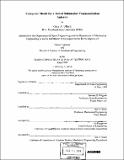Computer model for a towed submarine communication antenna
Author(s)
Ulrich, Gary A. (Gary Alan), 1962-
DownloadFull printable version (9.158Mb)
Other Contributors
Massachusetts Institute of Technology. Dept. of Mechanical Engineering.
Advisor
Jerome H. Milgram.
Terms of use
Metadata
Show full item recordAbstract
A finite difference computer model is developed to simulate the exposure statistics of a radio frequency buoyant antenna as it is towed in a random seaway. The model allows the user to prescribe antenna properties (length, diameter, density, etc.), sea conditions ( significant wave height, development of sea), and tow speed. The model then simulates the antenna-sea interaction for the desired duration to collect statistics relating to antenna performance. The model provides design engineers with a tool to predict antenna performance trends, and conduct design tradeoff studies. The antenna envisioned is a submarine floating antenna which would enable communications at speed and depth, greatly enhancing the stealth and survivability of the US Navy's submarine force.
Description
Thesis (Nav.E.)--Massachusetts Institute of Technology, Dept. of Ocean Engineering; and, (S.M.)--Massachusetts Institute of Technology, Dept. of Mechanical Engineering, 1999. Includes bibliographical references (leaves 97-98).
Date issued
1999Department
Massachusetts Institute of Technology. Department of Mechanical Engineering; Massachusetts Institute of Technology. Department of Ocean EngineeringPublisher
Massachusetts Institute of Technology
Keywords
Ocean Engineering., Mechanical Engineering.